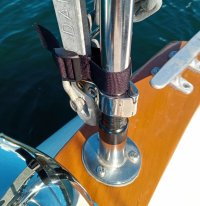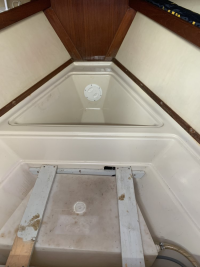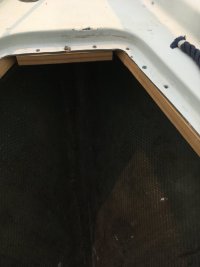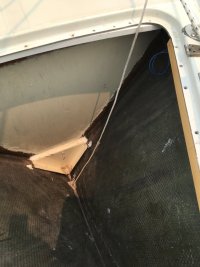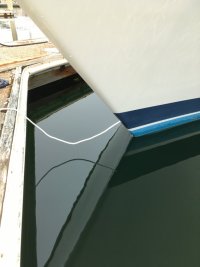peaman
Sustaining Member
I have read with interest the various posts about removal of the chain locker and related work, including this one. I was able to remove the chain locker with little effort after removing the many screws, and the drain tube came out without resistance, and no corrosion. I will describe my plan for reinstalling the locker/liner with drain below, but the purpose of this post is to seek advice on rebedding and rewiring the bow pulpit.
The four "feet" on the bow pulpit all showed various degrees of rust streaking around the foot pad at deck level as well as around the tubing at the top of each foot socket, and I would like to minimize that. The separate socket inherently allows water to enter the foot fitting just by draining down along the tubing. And from there, for the most part that water has nowhere to go. In the image below, the base plate of the two aft feet have a center hole, which is used for bow light wiring on the port side. The hole through the deck which is provided for that wiring was entirely plugged by sealant, but on that foot socket ONLY, there is a tiny (3/16") hole at the base of the socket above the mounting plate (see photo). No drain path existed on the starboard side since there is no deck opening or other means of drainage. No other feet have a drain hole or a hole in the deck where the foot is mounted. The two forward feet have no means of drainage at all.
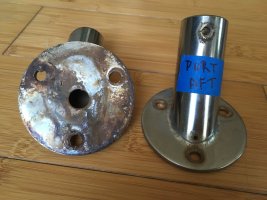
So here are the questions:
Is there any recommended way to seal the top of the foot sockets so they do not allow water to enter?
Given that one foot socket has a 3/32" drain hole, should the other three feet have one as well?
With the bow pulpit removed, this should be a good opportunity to replace the wiring for the bow light...unless that effort is likely to fail. Assuming others have made the effort to remove the original bow light wiring from the pulpit tubing, how well did that work out for you?
Back to the re-install of the liner and drain: my drain is an assembly of the same "Qest" grey plastic tubing used for the fresh water plumbing system. It appears that during the original build, a longer section of tubing was connected to the drain, that tubing was then fed through the hull opening at the bow, and the the tubing was cut flush. While I would rather see a more robust through-hull type fitting, I think the original intention is not a great risk if properly attended to. For re-installation, I intend to run a suitably sized cord through the drain tube, and then through the hull opening. The drain tube will be treated with sealant material, and the liner bed at deck level will be prepared with caulking, and then the liner will be lowered into place, while an assistant on the dock will "steer" the Qest tubing through the hull opening.
I think that procedure stands a good chance of working well, but we will see.
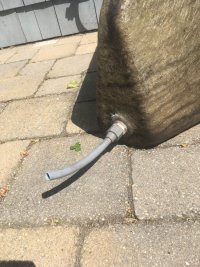
The four "feet" on the bow pulpit all showed various degrees of rust streaking around the foot pad at deck level as well as around the tubing at the top of each foot socket, and I would like to minimize that. The separate socket inherently allows water to enter the foot fitting just by draining down along the tubing. And from there, for the most part that water has nowhere to go. In the image below, the base plate of the two aft feet have a center hole, which is used for bow light wiring on the port side. The hole through the deck which is provided for that wiring was entirely plugged by sealant, but on that foot socket ONLY, there is a tiny (3/16") hole at the base of the socket above the mounting plate (see photo). No drain path existed on the starboard side since there is no deck opening or other means of drainage. No other feet have a drain hole or a hole in the deck where the foot is mounted. The two forward feet have no means of drainage at all.

So here are the questions:
Is there any recommended way to seal the top of the foot sockets so they do not allow water to enter?
Given that one foot socket has a 3/32" drain hole, should the other three feet have one as well?
With the bow pulpit removed, this should be a good opportunity to replace the wiring for the bow light...unless that effort is likely to fail. Assuming others have made the effort to remove the original bow light wiring from the pulpit tubing, how well did that work out for you?
Back to the re-install of the liner and drain: my drain is an assembly of the same "Qest" grey plastic tubing used for the fresh water plumbing system. It appears that during the original build, a longer section of tubing was connected to the drain, that tubing was then fed through the hull opening at the bow, and the the tubing was cut flush. While I would rather see a more robust through-hull type fitting, I think the original intention is not a great risk if properly attended to. For re-installation, I intend to run a suitably sized cord through the drain tube, and then through the hull opening. The drain tube will be treated with sealant material, and the liner bed at deck level will be prepared with caulking, and then the liner will be lowered into place, while an assistant on the dock will "steer" the Qest tubing through the hull opening.
I think that procedure stands a good chance of working well, but we will see.


